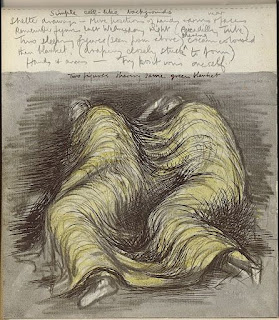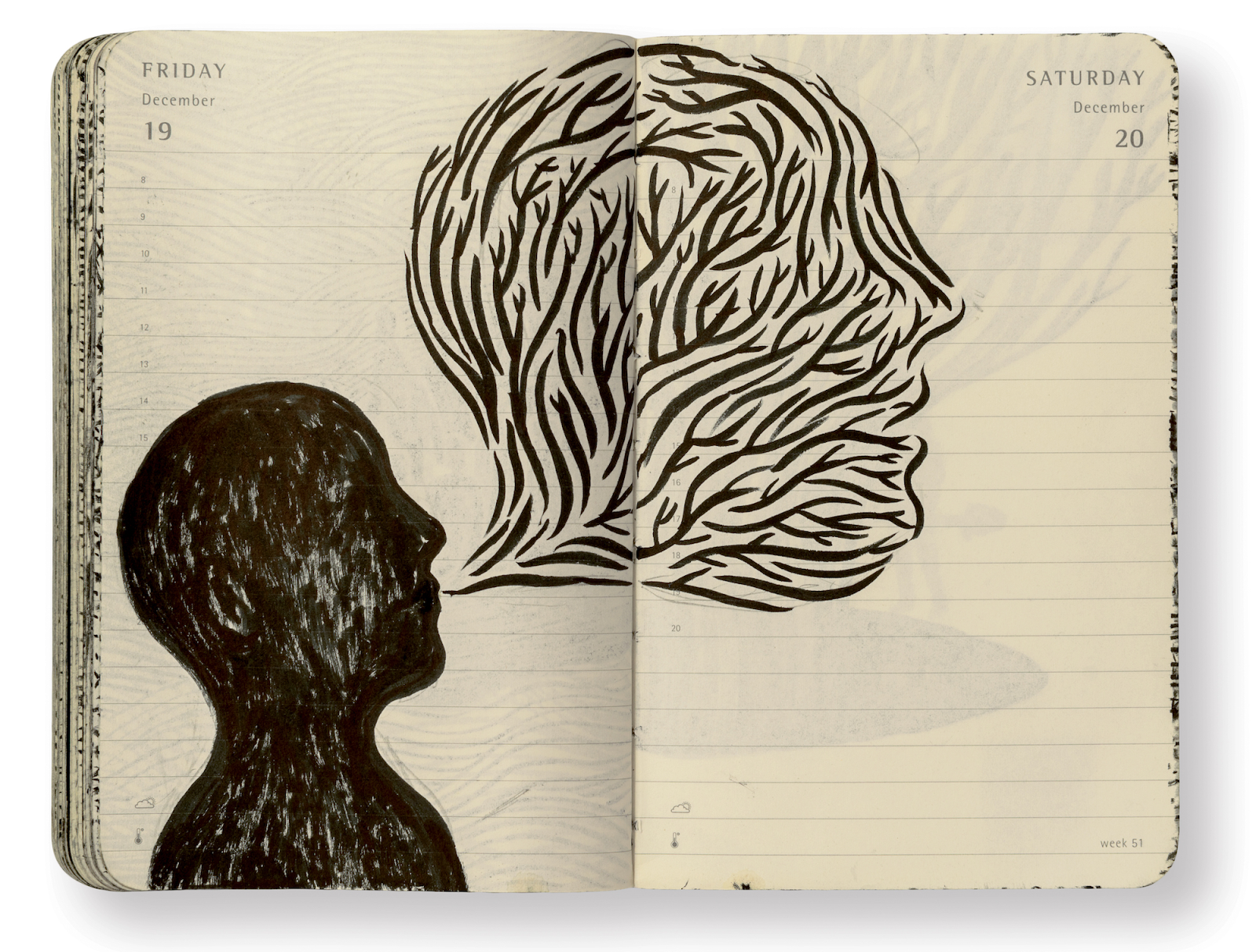The exhibition Piscean Promises is being held in the Workshop Press Gallery in Chapeltown. The gallery opens out into the street and everyone will be welcome, neighbours as well as those interested in art.
The Gallery is at 10 Back Newton Grove, Chapeltown, Leeds, LS7 4HW.
See this link below for details as to how to get there:
The exhibition began as most of my work does by having a conversation with someone. Huge amounts of dead fish were being washed up onto the English shoreline, the person I had been talking to had seen this and it had affected them deeply.
This was the text given out at the exhibition.
So why Piscean Promises?
It’s about the way people argue with each other, as well as the short-sightedness and myopic nature of human beings.
But first thecomedy, a joke about fish.
A goldfish has a little castle toy inside its bowl.
The goldfish swims around and around and around.
Here's what the goldfish thinks.
Hey, there's a castle!
Hey, there's a castle!
Hey, there's a castle!
etc. etc.
I don’t know of any jokes that fish have about humans; so perhaps I have to tell one for them.
A total of almost 80% of the world's fisheries are fully- to over-exploited, depleted, or in a state of collapse. Worldwide about 90% of the stocks of large predatory fish stocks are already gone. We are losing species as well as entire ecosystems.In 1992 the once thriving Canadian cod fishing industry came to a sudden and full stop when at the start of the fishing season no cod appeared. Overfishing had caused 40.000 people to lose their livelihood and an ecosystem was now in a complete state of decay. The European Union responded by putting in controls on how to fish in EU waters. However British fishermen want to take back control. Recently hundreds of thousands of fish were washed up onto the Cornish beaches, it was horrible said holidaymakers who were put off going onto the beach. Trawlermen sometimes underestimate the size of shoals, this means that they get too many fish in their nets. If this happens, to make sure they are safe from capsizing, a vessel has no choice other than to release the bottom of the net so that the catch falls away. However fish are quite delicate and vulnerable to damage due to the high number of them caught in the net. They are incapacitated as a result of being hauled to the side of the vessel, and when released from the net they are already effectively dead. These sightings are becoming more common as nets get bigger. This sort of ‘embarrassment’ may drive behavioural change within the fishing industry a Government spokesman said.
The vast majority of fish we eat are not farmed but essentially mined.
There are 10 natural resources that are critical to the functioning of the U.S. military industrial complex. The extraction of these under the ground resources which form the base on which industrial societies stand, is constructed in many instances through the use or threatened use of armed violence. As a result, armed violence plays a critical role in fostering political destabilisation, environmental degradation and ecological devastation. The ability of wealthy industrial societies to extract vast quantities of natural resources from the earth and get these resources distributed to where they want them also requires complex social arrangements that are instituted, organized, shaped, directed, and controlled by specific organizations, institutions, treaties, and laws, many of which are seen as the ones we should rely on once ‘free’ of the EU regulatory framework, such as the World Bank, International Monetary Fund, and World Trade Organization. These highly coercive institutions have multiple, often violent, negative, destabilising impacts on individuals, societies, and the environment.
Over the past 50 years, the average global temperature has increased at the fastest rate in recorded history.
Everything is connected.
The tragedy about humans.
Humans go around and around and around and can’t understand the fundamental contradiction between a profit-oriented economic system and long-term environmental sustainability. They think that the natural world is totally controllable by humans, and that the world is only of value in relation to what it has to offer to humans. The joke is that they always argue that they are right.
We treat the natural world in the way we do because we have no empathy towards it. We treat ‘others’ in a similar way.
There is little compassion for those who brave the seas on small boats in search of a life in Britain. There is an atrophy of imagination, further eroded by a right wing press breeding an anxiety that closes minds and shuts our doors in the face of other people. We live in a time of a monstrous betrayal, a time of historical amnesia and a cosy particularly British viciousness. What a miserable, pathetic distortion of the truth is this petty fear of outsiders, what a lamentable head in the sand attitude towards the reality of late capitalism.
There are no borders to humanity, no difference between ourselves and the rest of nature, only in the minds of the fools and bigots who build them. But still we vote them in.
This work is allegorical, based on conversations had with many of you and others, a response to the awful dawning of a post Brexit world and a coming Conservative liaison with the DUP climate change deniers.
Logic has failed us; these images are the product of dreams and unconscious reverie, as something tries to get out before it destroys its host from the inside. Personal associations are linked to images seen and new interpretations are begun. Truth is seen as a construction and part of the rhetoric of temporality, subjective experience being heightened by an awareness of the impossibility of communicating what is intended. Allegorical meaning is seen as an aesthetic form of understanding, rather than something made to affect a change in people’s behavior, which is something they have to do themselves. For this artist allegory is pre-eminently a kind of experience that senses the transitory nature of the world, one that gives an intimation of mortality, but it is also about transforming things into signs, these images are in effect an attempt to look for, ‘signs of the signs’ emerging.
Garry Barker 2017
Individual fish were photographed and made into cards.
The centrepiece of the exhibition was a swirling mass of ceramic fish. Each one had been made by myself and was thought about as an individual ‘portrait’ of a fish. The point being that we never think of fish as individual beings; we only think of them as a mass of undifferentiated things that we have unilaterally decided we have complete control over. Reference the recent arguments over amounts we can fish if we leave the EU. No one ever questions the rights of fish to be fished.
The drawings ranged from those about masses of dead fish to attempts by human beings to make peace with these usually alien creatures, and in the centre of all these various approaches to come to terms with our difficult relationship with fish was a large drawing that had been done in response to stories about Brexit and immigration and how Leeds itself would be re-shaped in a time of future global warming.
The final drawing I produced was large and complex, too complex to be photographed, so I developed a different way of recording it. click on this text to go to the image as photographed using a 360 degree rotating camera. You can guide yourself around by clicking on the arrows.
Details
These large drawings allow me to draw together several story threads and are part of my attempt to mythologise the stories told to me. For instance the graffiti type images of stick figures, drawn as if they are images painted directly on the white cliffs of Southern England, were my response to local Leeds graffiti identifying the edges of gang territory, and applying this to England itself, the white cliffs being Albion, and for many people a sign of being able to 'take back control', i. e. not to let any foreigners in. St Michael also stands on the cliff edge waiting to spear any trespassers. However the island of England is not as beautiful as people might imagine it to be. A boat full of migrants makes its way into the inner area of the drawing and as it does various stories are played out. newly housed immigrants spill out of their accommodation in a modernist tower block, buildings have been reduced to rubble due to war and the type of hostilities we usually only associate with the Middle East. There are refugee camps in England and a wall has been built between US and THEM. The land turns over and encloses the sky and in the countryside fields are inhabited by mutant cows.
So that people could identify with what was going on, certain details were taken directly from my own drawings of Leeds, in particular those done in the areas surrounding the place where I work and made on my daily walks way to and from the college of art.
I had also made some prints, which gave me an opportunity to actually sell some of my work as well as to use some colour for a change. In this case the term 'fishfingers' was enough to get my mind thinking about how we wrestle with ourselves and find it hard to accept that we are in fact no different from the fish we happily eat on a Friday. We are as they say, 'what we eat'.
Part two of this exhibition will be shown in the Leeds College of Art. 'Curator's Choice' will consist of a large glass vitrine hosting layers of ceramic fish.
See also other posts on exhibitions and my art practice:
Drawing it all together































































